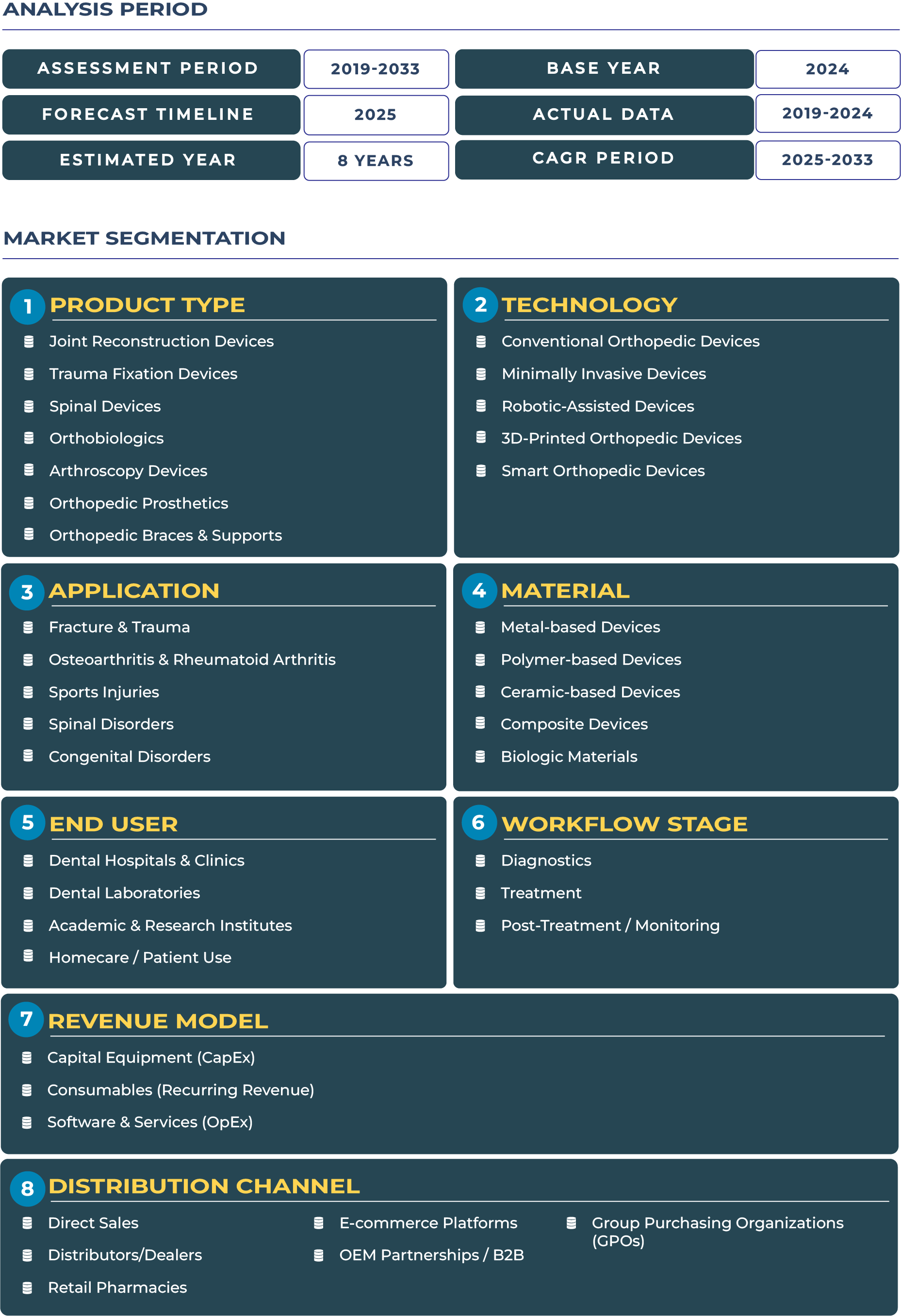Report Format:
![]()
![]() |
Pages: 110+
|
Pages: 110+
Germany Orthopedic Devices Market Outlook: Engineering Excellence Driving Growth and Global Exports
The German orthopedic devices market is anchored in the nation’s long-standing reputation for engineering precision and global exports. Germany’s robust medical device manufacturing ecosystem, supported by strong industrial clusters in regions such as Bavaria, Baden-Württemberg, and North Rhine-Westphalia, enables the country to be both a major consumer and exporter of orthopedic implants, prosthetics, and surgical systems. Known for high-quality standards and adherence to stringent Federal Institute for Drugs and Medical Devices (BfArM) regulations, the German market plays a central role in shaping the European orthopedic devices industry. According to DataCube Research, the market is valued at USD 3.75 billion in 2025 and is projected to reach USD 4.54 billion by 2033. This growth reflects Germany’s high volume of orthopedic procedures, dense network of specialized hospitals, and global export demand for advanced devices, despite cost-control pressures from statutory sickness funds.
Engineering Precision and Export Leadership Defining Germany orthopedic devices Industry
Germany orthopedic devices market outlook highlights a blend of domestic procedure demand and export-driven growth. Joint reconstruction implants and trauma fixation devices remain critical areas of demand, supported by one of the highest orthopedic procedure volumes in Europe. Precision-engineered spinal devices and arthroscopy solutions are gaining traction across Germany’s specialist hospitals and private clinics, further strengthening the country’s leadership in the sector. At the same time, Germany’s export base continues to reinforce its global position, with local manufacturers supplying advanced implants to other European markets and beyond. While growth remains moderate compared to more liberalized procurement markets, Germany orthopedic devices ecosystem is underpinned by a resilient industrial base, strong surgeon expertise, and continuous innovation pipelines. However, the market remains sensitive to political and economic pressures, including EU-level regulatory compliance costs and price containment measures imposed by statutory health insurers.
Drivers & Restraints: Balancing High Procedure Demand with Complex Procurement and Price Pressures
Driving Forces Strengthening Germany orthopedic devices Landscape
A major driver of Germany orthopedic devices industry is the large and consistent volume of orthopedic procedures performed across its advanced hospital system. Hip and knee replacements, supported by a rapidly aging population, are among the highest in Europe, providing steady demand for joint reconstruction and prosthetic devices. The country’s strong capital base for hospitals, including university medical centers in Berlin, Munich, and Heidelberg, enables regular investment in advanced orthopedic technologies such as robotics and high-end implants. Moreover, Germany benefits from one of the highest densities of specialist orthopedic surgeons in Europe, ensuring both technical expertise and adoption of sophisticated devices. This combination of infrastructure, skills, and patient demand creates a solid foundation for market resilience.
Restraints Limiting Growth Despite Market Strength
Despite its strong fundamentals, the German orthopedic devices market faces structural restraints. Procurement is fragmented across federal states (Laender), creating complexities for device manufacturers seeking market entry at scale. Price pressure from statutory sickness funds, which negotiate aggressively with hospitals, places downward pressure on reimbursement rates for orthopedic implants. Additionally, EU-wide regulatory compliance requirements under MDR (Medical Device Regulation) have increased certification costs, delaying the launch of innovative products. These barriers, combined with heightened scrutiny on cost-effectiveness, mean that while the German orthopedic devices ecosystem thrives on engineering excellence, growth remains moderated by systemic cost and regulatory factors.
Trends & Opportunities: Robotics, Specialist Clinics, and Precision Implants Defining the Future
Key Trends Shaping the German Orthopedic Devices Sector
Robotics is becoming increasingly prevalent in Germany’s private hospitals, particularly in metropolitan hubs such as Munich, Hamburg, and Frankfurt, where premium patients and insurers demand high-tech surgical solutions. Specialist orthopedic clinics, focusing solely on musculoskeletal care, are expanding rapidly across both urban and semi-urban areas, creating niche demand for arthroscopy devices and biologics. In addition, the rising adoption of private health insurance among Germany’s population is enabling faster uptake of premium implant lines, as patients with supplementary insurance seek advanced solutions not always covered under standard statutory reimbursement frameworks.
Opportunities Emerging Through KOL Advocacy and Regional Distribution Networks
Germany orthopedic devices industry presents opportunities for manufacturers that leverage Key Opinion Leader (KOL)-led clinical rollouts, where leading surgeons advocate for premium implant lines across hospitals and clinics. Partnerships with regional distributor alliances are also critical for navigating Laender-level procurement systems, ensuring market access in a fragmented environment. Furthermore, localized representatives for premium implant brands can drive differentiation in competitive tenders. With Germany’s reputation for precision medicine and its strong export capabilities, vendors that integrate patient outcomes data with advanced engineering stand to gain significant traction both domestically and internationally.
Competitive Landscape: Global Leaders and Local Specialists Driving Innovation
Germany orthopedic devices landscape features a combination of international players and strong domestic champions. Aesculap (a division of B. Braun), based in Tuttlingen, continues to be a leader in joint reconstruction and spinal solutions, leveraging Germany’s engineering expertise to serve both local and global markets. International companies such as Stryker, DePuy Synthes, and Zimmer Biomet maintain a strong presence in Germany, investing in robotics-enabled systems and premium implants. Recent strategies include deploying regional specialist field teams to navigate Laender procurement, sponsoring surgeon training centers to expand clinical familiarity with robotics, and offering leasing options for high-cost surgical equipment to reduce hospital capital strain. These strategies are increasingly aligned with Germany’s procurement dynamics and the emphasis on cost-effectiveness. With continuous investments in digital health integration and surgeon-led innovation, the competitive landscape remains robust, positioning Germany as a key player in the global orthopedic devices industry.







